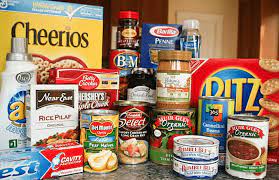In September, the Greater Princeton AYLUS (GPA) completed a food drive for local food banks.
GPA collected thousands of the following non perishable nutritious foods, such as tuna, chicken, salmon, fruits and vegetables, pasta and rice, soups, non-sugary cereal, and personal care items as well.
12 of the Best Non-Perishable Foods
Non-perishable foods, such as canned goods and dried fruit, have a long shelf life and don’t require refrigeration to keep them from spoiling. Instead, they can be stored at room temperature, such as in a pantry or cabinet.
They’re not only standard kitchen items but also favored by backpackers and campers who can’t bring perishable foods like fresh meats, dairy, and vegetables on the trail.
What’s more, non-perishable goods are essential in emergency situations and favored by charitable organizations that feed or give groceries to people facing homelessness or food insecurity.
Although some items like boxed macaroni and cheese are packed with preservatives and other unhealthy ingredients, quite a few nutritious non-perishable foods are available.
Here are 12 of the healthiest non-perishable foods.
- Dried and canned beans
With a long shelf life and high nutrient content, dried and canned beans are smart non-perishable food choices. Canned beans can be kept at room temperature for 2–5 years while dried beans can last 10 or more years, depending on the packaging.
In fact, one study found that pinto beans stored up to 30 years were considered edible by 80% of people on an emergency food use panel.
Beans are an excellent source of fiber, plant-based protein, magnesium, B vitamins, manganese, iron, phosphorus, zinc, and copper. What’s more, they pair well with most foods and make hearty additions to soups, grain dishes, and salads.
- Nut butters
Nut butters are creamy, nutrient-dense, and delicious.
Although storage temperatures can affect shelf life, commercial peanut butter keeps for up to 9 months at room temperature. Natural peanut butter, which does not contain preservatives, lasts up to 3 months at 50℉ (10℃) and only 1 month at 77℉ (25℃).
According to the United States Department of Agriculture (USDA), almond butter keeps for up to 1 year at room temperature while cashew butter keeps up to 3 months.
Nut butters are a rich source of healthy fats, protein, vitamins, minerals, and powerful plant compounds, including phenolic antioxidants, which are compounds that protect your body against oxidative stress and damage by unstable molecules called free radicals.
Jars of nut butter can be stored in your pantry while smaller packets can be taken backpacking or camping for an on-the-go snack.
- Dried fruits and vegetables
Although most fresh fruits and vegetables have a short shelf life, dried produce is considered non-perishable. When properly stored, most dried fruit can be safely kept at room temperature for up to 1 year, and dried vegetables can be kept about half that time.
You can choose from a variety of dried fruits and vegetables, including dried berries, apples, tomatoes, and carrots. You can also use a dehydrator or oven to make your own dried fruits and vegetables. Vacuum-sealed packaging can help prevent spoilage.
Dried fruits and veggies can be enjoyed as a snack or added to trail mix. Plus, dried veggies can be rehydrated by adding them to soups or stews if fresh produce isn’t available.
- Canned fish and poultry
Although fresh fish and poultry are packed with nutrients, they’re highly perishable. All the same, canned varieties can be safely kept without refrigeration for long periods — up to 5 years at room temperature.
Tuna and other seafood products are also sold in lightweight packages known as retort pouches, which are perfect for smaller pantries and backpacking. Seafood in retort pouches has a shelf life of up to 18 months.
Chicken and other meats can be found in retort pouches as well, though you should refer to the packaging for shelf life information.
- Nuts and seeds
Nuts and seeds are portable, nutrient-dense, and shelf-stable, making them non-perishable food staples. Favored by backpackers and hikers for high calorie snacking, they’re also great to have on hand in any situation.
On average, nuts last about 4 months when kept at or near room temperature (68℉ or 20℃), though shelf life varies greatly between nut varieties.
For example, cashews can be kept for 6 months at 68℉ (20℃) while pistachios only last 1 month at the same temperature.
Seeds have comparable shelf lives. According to the USDA, pumpkin seeds stay fresh for 6 months at room temperature.
- Grains
Whole grains like oats, rice, and barley have a much longer shelf life than other popular but perishable carb sources like bread, making them a smart choice for long-term food storage.
For example, brown rice can be kept at 50–70℉ (10–21℃) for up to 3 months while farro lasts up to 6 months at room temperature.
Grains can be added to soups, salads, and casseroles, making them a versatile non-perishable ingredient. Plus, eating whole grains may reduce your risk of type 2 diabetes, heart disease, and certain cancers.
- Canned vegetables and fruits
Canning has long been used to lengthen the shelf life of perishable foods, including fruits and vegetables.
The heat used during canning kills potentially harmful microorganisms, and the characteristic seal of canned foods keeps new bacteria from spoiling the contents.
The shelf life of canned fruits and vegetables depends on the type of produce.
For example, low-acid canned vegetables, including potatoes, carrots, beets, and spinach, last 2–5 years at room temperature.
On the other hand, high-acid fruits like grapefruit, apples, peaches, berries, and pineapple last just 12–18 months. The same goes for vegetables packed in vinegar, such as sauerkraut, German potato salad, and other pickled vegetables.
When shopping, choose canned fruits packed in water or 100% fruit juice rather than heavy syrup, and opt for low sodium canned veggies whenever possible.
If you’re crafty in the kitchen, consider canning at home using store-bought or garden-grown vegetables and fruits. If you don’t know how, you can consult numerous books or online tutorials.
- Jerky
Meat preservation is a practice used since ancient times to keep protein sources from spoiling. Specifically, jerky is made by curing meat in a salt solution, then dehydrating it. Preservatives, flavorings, and other additives are sometimes used during processing.
Many types of jerky are available, including beef, salmon, chicken, and buffalo. There are even plant-based jerky alternatives made from coconut, banana, and jackfruit. That said, note that these alternatives are not nutritionally equivalent to meat-based jerkies.
Commercial jerky can be safely kept in the pantry for up to 1 year, though the USDA recommends that homemade jerky be stored at room temperature for a maximum of 2 months.
Any kind of jerky can be enjoyed in moderation, but the healthiest options are those that don’t contain added sugar, artificial flavors, or preservatives.
- Granola and protein bars
Granola and protein bars are a go-to food for backpackers and hikers thanks to their long shelf life and nutrient composition.
Many granola bars stay fresh for up to 1 year at room temperature. Likewise, most protein bars have a shelf life of at least 1 year, though it’s best to check the label on individual products for expiration information.
What’s more, granola and protein bars can be highly nutritious as long as you choose the right kinds. Look for brands that are full of hearty ingredients, such as oats, nuts, and dried fruit, and contain minimal added sugars and artificial ingredients.
- Soup
Canned and dried soups are an excellent choice when stocking your pantry. They’re also preferred by food donation organizations.
Most canned soups are low in acid and can last up to 5 years at room temperature. The exception is tomato-based varieties, which have a shelf life of about 18 months.
Although most dried soup mixes should last up to 1 year in storage, it’s best to check labels for expiration dates.
Choose soups that are rich in healthy ingredients like vegetables and beans, and select low sodium products whenever possible, as consuming too much added salt may harm your health.
- Freeze dried meals
Freeze drying uses sublimation, a process in which ice is converted directly into vapor, to remove water from food so that it lasts longer at room temperature. Freeze dried meals are popular among backpackers because of their light weight and portability.
Freeze dried foods and ready-to-eat freeze dried meals are made for long-term storage — with some products boasting a 30-year taste guarantee.
Many companies, including Wild Zora and AlpineAire, make delicious, freeze-dried meals that are not only healthy but also accommodate specific dietary patterns.
- Shelf-stable milk and nondairy milk
While fresh milk and some nondairy alternatives like almond and coconut milks have to be refrigerated, shelf-stable milk and many nondairy milks are made to keep at room temperature.
Shelf-stable or aseptic milk is processed and packaged differently than regular milk because it’s heated to higher temperatures and packed in sterile containers.
One study found that shelf-stable milk had a shelf life of up to 9 months when kept at 40–68℉ (4–20℃).
Plant-based drinks like soy milk packaged in flexible materials, including plastic, paper, and aluminum, similarly last up to 10 months, while canned coconut milk keeps up to 5 years at room temperature.
Shelf-stable and plant-based milks can be used when refrigeration isn’t available. Powdered milk is a good alternative, with an estimated shelf life of 3–5 years when kept in a cool, dark place. It can be reconstituted with clean water in small portions as needed.
GPA honors the equality of all people and strives for a just, prosperous, and peaceful society for all. We respond to the needs of the community to build alliances that will have the most meaningful impact in addressing issues of poverty. We provide a range of integrated services that build community, nurture self-worth and independence, and offer resources for children, families, and communities to overcome poverty and its lasting effects.
GPA food drive participants: Jeffrey Jiang (9/15, 2 hrs), Steven Li (9/15, 2 hrs), Jonathan Yang (9/16, 1 hr), Michael Yang (9/16, 1 hr), Shuming Wang (9/16, 1 hr), Catherine You (9/16, 1 hr), Melanie You (9/16, 1 hr), Cindy Chen (9/16, 1 hr), Weiran Liu (9/16, 6 hrs), Waverly Willis (9/16, 2 hrs), Leah Zong (9/17, 1 hr), Jerry Zong (9/17, 1 hr), Claire Tang (9/18, 0.5 hrs), Kyson Zhou (9/20, 1 hr), Katherine Zhu (9/22, 2 hrs)




























